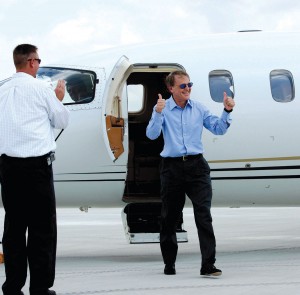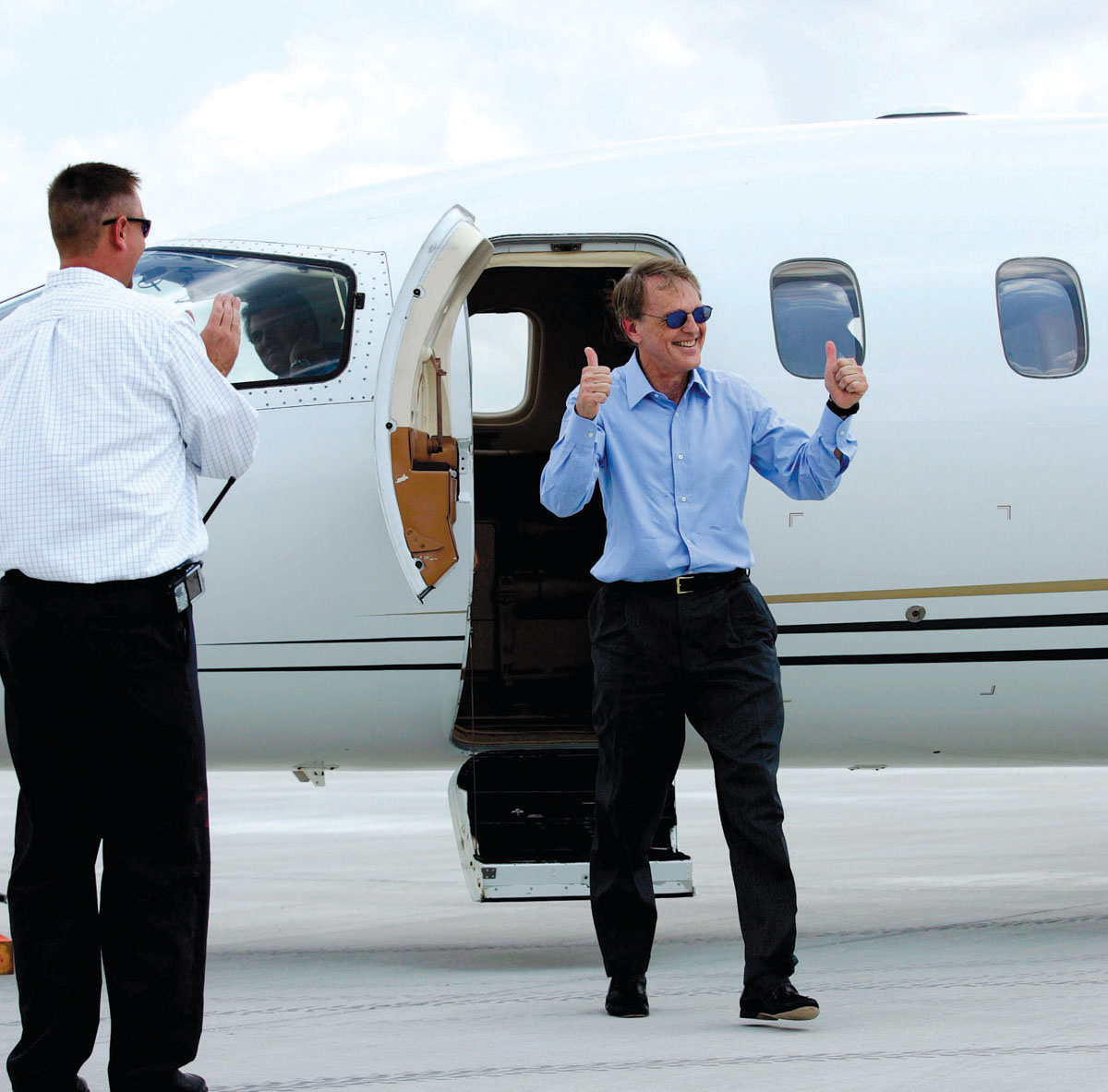
Ron Henriksen celebrated a birthday milestone August 6 by becoming the first pilot to land at his new Houston Executive Airport. Henriksen was joined by a crowd of 50 well-wishers including Houston Executive Airport Director Andrew Perry.
The usual revelry associated with a birthday party took a decidedly “flightier” approach August 6 when businessman Ron Henriksen loaded his family aboard his twin-engine Piaggio P-180 Avanti and took to the skies, becoming the first pilot to land at his new Houston Executive Airport in celebration of his 60th birthday.
Accompanying Henriksen on the flight from Sugar Land to the airport were Henriksen’s wife Sheri and sons, 13-year-old James and 11-year-old Matt.
“I expected the flight to take about 4 ½ minutes, but due to wind conditions, we landed in about 6 minutes—a fitting number considering the occasion,” said Henriksen.
Henriksen landed at 1:30 p.m., followed by Drew Coats, an executive with Houston Executive Airport, in his Cessna 172, and Jay Tribble, of Tribble & Stephens, flying his Cessna Centurion Turbo 210.
Houston Executive Airport (HEA) is a commercial development of WCF, LLC, owned by Henriksen, a Houston native. Scheduled to open to the public in January 2007, the airport is located west of Houston in South Waller County, north of I-10 and west of FM 2855, an area of rapid growth and business development. HEA replaces Air Rice, a private airport built in 1962 primarily used for crop-dusters.
Located in Brookshire, Texas, HEA will cater to business and general aviation aircraft. With an eye for coming growth, Henriksen has long-range plans for the airport’s runway to be extended to 7,000 feet to accommodate larger planes.

Ron Henriksen lands his twin-engine Piaggio P-180 Avanti August 6, becoming the first pilot to land at his new Houston Executive Airport.
Joining the crowd of 50 well-wishers on the ground were Andy Perry, Houston Executive Airport director; Roberta Long, executive finance director; and David Hannah III, construction supervisor, who broke into “Happy Birthday” as Henriksen exited the plane. Other guests included brothers Bob Cardiff and George Cardiff, the previous owners of the former crop-dusting facility where the airport is being constructed.
Henriksen, a former commercial pilot, is realizing a boyhood dream with the near completion of the 2-year project.
“I took my first flying lesson when I was in my first year of college,” said Henriksen. “From the moment my feet left the ground, I was hooked on aviation.”
Henriksen continued his passion for planes while attending Sam Houston State University where he graduated with a degree in mathematics. He had a 15-year career in commercial aviation before entering the telecommunications field.
The significant growth of the Energy Corridor along Interstate 10 was a natural draw for an airport located west of Houston, said Henriksen. But there were other guiding factors as well.
“General aviation airports are disappearing around the country,” said Henriksen. “When I saw the closing of Houston’s Andrau Airport and Austin’s Robert Mueller Airport, I was determined to build this new airport with private investment to ensure its longevity and positively impact the local community.”
Henriksen said Houston Executive Airport will be a tremendous asset to the local community, providing a significant increase in tax revenue to the county and Royal ISD. In addition, Henriksen sites the value to families.
“As a father, I’m excited about the opportunity to expose children to the joy of aviation,” he said. “Airports are really quite beautiful. They preserve green space as metropolitan areas expand, and to that end, we have plans for a public park where families can picnic, play sports and let their own kids watch planes come and go. And who knows? There may be a child out here whose life, like mine, will be changed forever by learning about the opportunities available in the field of aviation.”
For more information, visit [http://www.HoustonExecutiveAirport.com].











